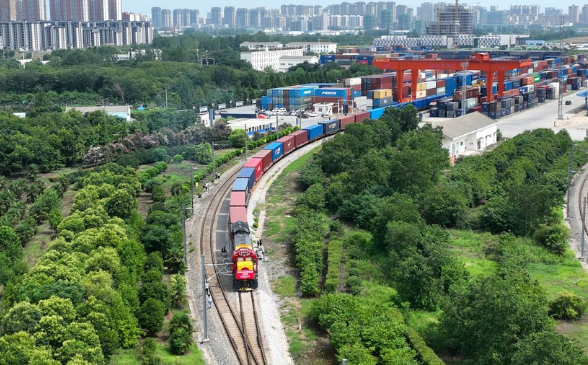Sino-European Freight Line: A Rail Bridge Connecting Continents

The China-Europe freight train has emerged as a vital artery for global trade, spanning the vast geographical gap between Asia and Europe. This efficient rail network facilitates the smooth transit of a wide array of goods, ranging from electronics and machinery to agricultural products and consumer goods.
The China-Europe freight train offers numerous advantages over traditional maritime shipping routes. {Firstly|First|, it provides a shorter transit time, reducing lead times and improving supply chain performance. Secondly, the rail network is better protected to disruptions such as port congestion or weather impairments. Finally, the freight train promotes green transportation by reducing carbon emissions compared to air or sea freight.
- the China-Europe freight train has become a platform for cultural interaction between China and Europe. The movement of goods and people along this rail route fosters understanding and strengthens connections between the two continents.
- Examining to the future, the China-Europe freight train is poised for continued development. Investments in infrastructure and technology are expected to further improve its efficiency, solidifying its role as a vital component of global trade networks.

A surge of China-Europe Railway Express: Unlocking Trade Potential
The China-Europe Railway Express has emerged as a crucial trade route, bridging the economic powerhouses of China and Europe. This groundbreaking rail network offers a rapid alternative to traditional maritime transport, drastically reducing transit times and enhancing global supply chains. The growing network spans thousands of kilometers, connecting major cities across Asia and Europe, fostering boosted trade and investment.
- Additionally, the China-Europe Railway Express facilitates cultural exchange and tourism between the two continents.
- Consequently, this rail network has transformed into a catalyst for economic growth and partnership in Eurasia.
Looking ahead, the China-Europe Railway Express is poised to further expand its reach, revealing even greater trade potential between China and Europe.

Faster, Greener, and More Efficient: The Future of China-Europe Rail Transport
The China-Europe rail transport corridor is poised for significant growth in the coming years. Driven by a robust demand for faster, more environmentally friendly trade routes, advancements in technology and infrastructure are clearing the way for an more interconnected future. This active corridor offers numerous benefits to both regions, including shorter transit times, lower transportation costs, and a significant reduction in carbon emissions compared to traditional air transport.
With ongoing commitments in high-speed rail networks, modernized terminals, and efficient supply chain systems, the China-Europe rail corridor is steadily becoming a vital artery for global commerce. Furthermore, this integration fosters economic interaction between Europe and Asia, contributing to a more interconnected and thriving world.
Connecting China and Europe by Rail
Freight trains are significantly connecting China and Europe through a sophisticated rail network, marking a game-changer in global trade. This initiative , often referred to as the New Silk Road on Rails, is fostering stronger economic ties between the two regions . A growing number of freight trains traverse the vast route each week, transporting a multitude of goods, from electronics and machinery to agricultural products and consumer goods.

The establishment of this rail network has many advantages . It shortens transportation time and expenses , making it a significantly viable option for businesses. Moreover, the New Silk Road on Rails stimulates regional development and fosters job opportunities along the route. The growth of this rail network has the potential to substantially enhance economic cooperation between China and Europe, shaping the global trade landscape for years to come.
China to Europe by Rail: A Logistics Revolution in Progress
The traditional Silk Road has been reimagined for the modern age. With a burgeoning system of rail lines stretching from eastern China to European gateways, transporting goods by rail is emerging as a viable alternative to shipping. This transformative shift in logistics is fueled by factors like shorter transit times, decreased carbon emissions compared to air freight, and the increasing demand for faster and more environmentally friendly global trade.
The plusses of rail transport are clear in the rising popularity of this route among businesses. A growing number of companies are leveraging the effectiveness of rail to move a broad range of goods, from electronics and machinery to agricultural products and consumer products.
This changing landscape presents both hurdles and potential for the future. Overcoming issues like harmonized policies across different countries and investment in infrastructure will be crucial to fully realize the potential of this logistics revolution.
Bridging East and West: The Impact of China-Europe Train Freight
The expansion of Sino-European train freight represents a significant evolution in global trade, spurring closer economic ties between the East and West. This innovative network, spanning thousands of kilometers, provides a cost-effective alternative to traditional maritime shipping routes, substantially reducing transit periods.
The impact extends beyond solely facilitating trade. These rail routes foster China to Europe freight train cultural interaction, enhance regional progress and create new possibilities for cooperation. Additionally, the environmental advantages of rail freight, with its lower carbon footprint compared to air or sea transport, make it a more eco-friendly choice for global commerce.
- Reduced transit times
- Economic growth in participating regions
- Enhanced cultural exchange
- Lower carbon emissions compared to other modes of transport